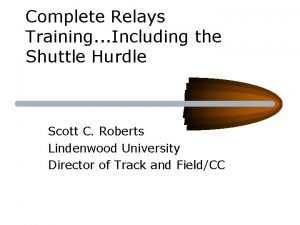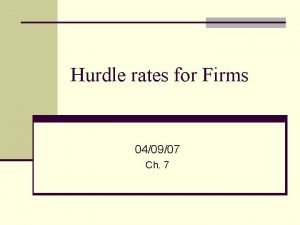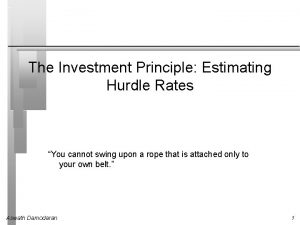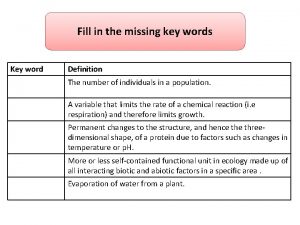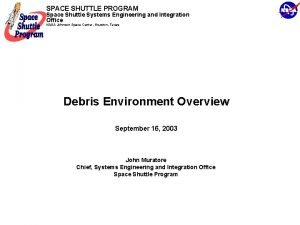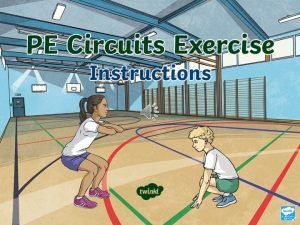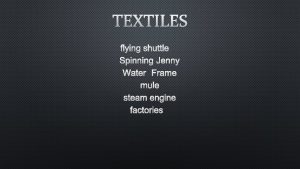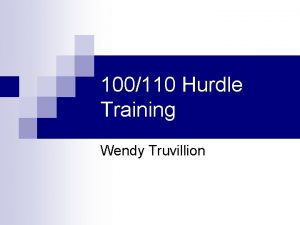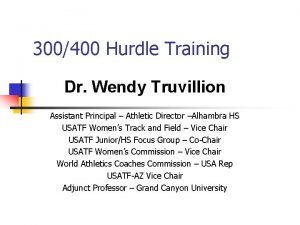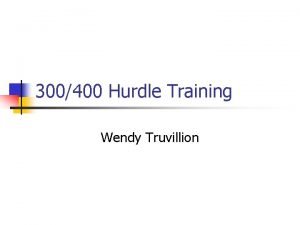Complete Relays Training Including the Shuttle Hurdle Scott






























































- Slides: 62

Complete Relays Training. . . Including the Shuttle Hurdle Scott C. Roberts Lindenwood University Director of Track and Field/CC

Relay Philosophy o 2+2=5 o Run Fast or don’t finish (4 x 100 m).

SPRINT RELAYS Blind Exchange

The Exchange · Incoming runner · Run as if attempting to pass the outgoing runner · Don’t let the baton go, it should be taken · Place the baton across the ulnar boarder to facilitate grasp reflex.

The Exchange · Incoming runner · The outgoing runner can’t see the baton. Put it where it belongs. · Must run at maximum even after the exchange so as not to program premature deceleration.

The Exchange · Outgoing runner · Determines the tempo of the exchange · The reaction to start must take place exactly at the coincidence point between the marker & the incoming runner.

The Stance · Outgoing runner · The standing start with upright head is better for observation of the “go” or “coincidence point”. · Better for beginners. · When doing this, get the arms going prior to incoming runner’s arrival at “go” mark. · · Front and back feet facing forward Left arm or inside arm is back

The Stance · Outgoing runner · 3 or 4 point starts are advantageous for acceleration purposes for experienced relay runners.

The Exchange · Outgoing runner · The outgoing runner must make every effort to reach the highest possible acceleration rate at the moment the incoming runner reaches the coincidence mark to reduce slowdown of baton in the zone. · The outgoing runner must provide a high, steady target for the baton

The Exchange · Outgoing runner must never slacken the pace, even when reaching back for the baton. · Never fish for baton.

·Establishing a “Go” mark · Recommended that you start athletes at the Olympic mark. Even 13 second 100 m runners don’t reach top speed until about 25 m and anyone faster doesn’t until about 30 -35 m

Establishing a “Go” mark · Trial and error · 18 -20 ft. lengths for athlete’s of similar ability. · Measure in spikes along the inside lane line

Establishing a “Go” mark · Mathematical Formula · Time incoming runner over last 25 m to the exchange point and outgoing runner from the Olympic acceleration to the exchange point. · Example: Incoming runner=2. 6 sec. over last 25 m § § § Outgoing runner=3. 2 sec. from Olympic to exchange point in zone. 25 m/2. 6=9. 62 m/sec. (9. 62 m/sec)(3. 2 sec. )=30. 78 m

Relay Marks Try to use the box (6 heel-toe stepssquare) as opposed to the single “go” mark

Relay Marks o Relay Marks · Carry a supply of the following marks to accommodate any circumstance: · · · 1/2 tennis balls vinyl tape in assorted colors tongue depressors chalk in various colors index cards with thumb tacks Big washers wrapped in tape

Passing Technique-Upward Pass (“V” position) · One of the oldest methods used today · · The outgoing runner extends the receiving hand & arm back at a diagonal angle. The incoming runner places the baton, w/an upward, sweeping motion into the inverted “V” formed by the receiver’s hand, which is positioned palm down.

Passing Technique-Upward Pass (“V” position) · Advantage · · · It is easy to learn. More consistent. It’s a safe pass. It fits in best with the natural movements of top speed running. It can, be carried out efficiently and with very little extraneous movement. By allowing the giver to be close to the receiver at the moment of exchange, it entails a minimum loss of speed.

Passing Technique-Upward Pass (“V” position) · Disadvantages • · · · less free distance smaller target area no facilitation of the grasp reflex baton placement in the hand may require adjustments by outgoing runner · The passer must make efforts to place the baton deep into receiver’s hand. Actually make hand-to-hand contact.

Passing Technique-Palm Up or Jet Pass · Most popular in the USA. · · The outgoing runner accelerates to a predetermined spot in the zone or responds to a verbal command. The arm is extended back straight. The target hand is held high with the palm up, fingers slightly spread and thumb toward the torso. The incoming runner places the baton, w/ a downward sweeping motion.

Passing Technique- Palm Up or Jet Pass · Advantages • good free distance · larger target area (high and consistent) · Allows baton to be placed across the ulnar boarder of hand facilitating the grasp reflex · Better placement of baton in hand requiring less adjustment by outgoing runner. · The time spent w/arm extended will be shorter & the pass will be completed in fewer strides. · The hand-to-hand transfer is faster.

Passing Technique- Palm Up or Jet Pass · Disadvantages • The timing/placement by the passer is crucial • Requires more time in practice. • Requires shoulder flexibility · If you have to bend forward to get the hand high, you sacrifice free distance. · Hard to accelerate if you break at the waist.

Passing Technique-Thumb Down or Push Pass · Growing in popularity · · Same as the palm up method, except that the outgoing runner extends the hand back w/palm facing the incoming runner with the thumb pointing down to the track. The incoming runner pushes the stick into the palm.

Passing Technique- Thumb Down or Push Pass · Advantages · Highest and most steady target · Good horizontal movement of the vertical baton w/good free distance. · Incoming runner can push baton into hand moving it less and reducing chance of missing target.

Passing Technique- Thumb Down or Push Pass · Disadvantages • Requires shoulder flexibility · No safety net after baton leaves hand.

Passing Technique · Snatch Pass · Advantages · Very small change-over time · Allows far better acceleration by the outgoing runner. (doesn’t have to run with hand back, if they miss, just pump and reach again) · Incoming (fatigued) runner doesn’t have to perform technically at the end of a long sprint.

Passing Technique · Snatch Pass · Disadvantages · Leaves considerable room for error · No ability to visually make adjustments. Responsibility for the exchange is switched from the incoming runner to the outgoing runner.

Focus Incoming Runnerfocus on the point of exchange Outgoing Runnerfocus on the exchange hand

Selection & Placement of Personnel · Lead off leg requirements · · Must be a confident & capable starter Possibly a hurdler-due to the need for high frequency. Or a shorter athlete-with low center of gravity. Solution to a negative-if one of your best four can’t act as an outgoing runner, they end up here. They will run a distance of 95 m with the baton, if it is passed 5 m inside the exchange zone. (104. 5 m if exchanging everyone equally)

Selection & Placement of Personnel · 2 nd leg requirements · Fastest athlete · Often the tallest athlete · Starting at the fly, this athlete will run 125 m & carry the baton for 110 m receiving it 5 m inside the first zone & passing it 15 m inside zone two (123. 5 m total and 99 m w/stick if exchanging everyone equally)

Selection & Placement of Personnel · 3 rd leg requirements · · Best stick work, versatile performer Look for a hurdler to adapt to the curve A good place to hide the weak link Starting in the middle of the fly, this leg runs 110 m. They will carry the baton only for 90 m if baton is received 5 m from end of zone two & passes 5 m into the final zone. (123. 5 m total and 99 m w/stick if exchanging everyone equally)

Selection & Placement of Personnel · 4 th leg requirements · 2 nd fastest athlete · Competitive nature, reliable & adaptable · 119 m total (94. 5 m w/stick if exchanging everyone equally)

4 x 100 m Drills o o Bottle Drill Off-The-Wall Drill Push Drill 4 Person Standing/Jogging

4 x 200 m Relay or 200 m legs of Medleys

4 x 200 m Relay o Incoming Runner • Same basic rules apply as 4 x 100 m o Outgoing Runner • The standing start with upright head is better for observation of the “go” or “coincidence point”.

4 x 200 m Relay · The outgoing runner will judge the incoming runner and release slower. · The outgoing runner must provide a high, steady target for the baton

Establishing a “Go” Mark ü Recommended that you start athletes just inside the zone. ü ½ of your 4 x 100 m measurements as your “Go” mark.

Passing Technique · Can either be palm up or thumb down technique w/modification. (semiblind) · Extend hand back on the verbal signal (or nonverbal) and look down the extended arm. Visually watch the baton into your hand.

Selection & Placement of Personnel o For continuity purposes, keep the same order as the 4 x 100 m Relay. o See 4 x 100 m Relay placement criteria.

4 x 400 m Relay and Longer Relays

4 x 400 m Relay and Up o Passing Technique · Open (Visual) Exchange · Runners carry the baton in their right hand, receive it in left hand immediately move it to their right. · Left hand is held up high to provide high steady target. · Accept the stick with the thumb up (like reaching for a glass of water) ·Upon receiving the baton, the outgoing runner accelerates out of the zone and changes the baton to the right hand.

The Exchange · Incoming runner • Aim toward the curb (inside) of the outgoing runner · Hold baton up and steady (in right hand) · Hold position or go off the track on the inside.

The Exchange Outgoing runner ·Gauge incoming runner’s speed and pull them in ·Responsible for the tempo of the exchange (incoming runner is too tired to make adjustments) ·Short fast exchange. Take the stick aggressively ·Take baton w/left hand switch to right. ·Move to inside of track as soon as possible

Selection & Placement of Personnel-4 x 400 m · Lead off leg requirements · · · Job is to get the team out front & make the exchange with a lead. Must be aggressive enough to get the lead. Strong w/a good sense of pace. Must realize that the stagger is for three turns and must not be disconcerted by the appearance or athletes in the outside lanes as having a great lead. Will run approximately 500 m total with the additional 200 m stagger to the second exchange zone. May be the 2 nd fastest person on the team.

Selection & Placement of Personnel-4 x 400 m · Second leg requirements · · · Job is to keep the team in the race. Must be strong enough to withstand physical contact at the breakpoint and be able to run in traffic. Must be mentally strong enough to challenge for the lead or to hold one.

Selection & Placement of Personnel-4 x 400 m · Third leg requirements · · • · Job is to put the team in position to win. Must be confident and able to run from the front or from behind. Must try to set up the anchor runner in a good race position to run their best. Often is the second-best possible anchor leg on the team.

Selection & Placement of Personnel-4 x 400 m · Anchor leg requirements · · • Job is to put the relay away. Must be confident and able to run from the front or from behind. Must not always be the fastest but rather the athlete who will run the best last leg. All four runners must be placed and balanced so as to yield the best team result.

Tactics of 4 x 400 m Relay and Up n Duds and Studs Theory o If you have 1 stud and 3 duds (stay close, catch up, hang in) n Dud/Stud/Dud o If you have 2 studs and 2 Duds (stay close, catch up, hang in, catch up) n Dud/Stud/Real Dud/Stud o If you have 3 Studs and a Dud (get lead, hang in, catch up, keep lead) n Stud/Dud/Stud or Stud/Dud/Stud

Tactics of 4 x 400 m Relay and Up n Your athletes must run from every position. n Know your athletes’ strengths & weaknesses. n Your team must always be in the race (no more than 10 m out) n If you have the lead, run a strong first 300 m. n If you are behind, know the speed of the leg & distance left. n Run from all lanes in practice sessions.

4 x 400 m Drills o 5 Person Relay o Rabbit Drill

Shuttle Hurdle Relay

Shuttle Hurdle Relay · When the incoming runner comes over the last hurdle, the outgoing runner must come into the set position. ·As the incoming runner crosses the “go” line, which is typically one meter from the finish, they can give a “go” command.

Shuttle Hurdle Relay o Possible order would be: (3 studs, 1 dud) n n Fastest Slowest 2 nd Fastest

Shuttle Hurdle Relay o Another possible order (if not two much difference) (4 studs) n n 2 nd Fastest #3 hurdler #4 hurdler Fastest

Shuttle Hurdle Relay o Another possible order (2 studs, 2 duds) n n Fastest Slowest 2 nd Fastest

Shuttle Hurdle Relay o Wind changes the entire complexion of this race. n Always put your strongest hurdlers against the wind as they are less likely to have step problems. o You want to stay in the race as long as possible n Putting pressure on other teams to catch up can cause them to stumble.

What This Means o There are many different styles of relay racing and techniques to get you to the finish line. You must choose the one that works best for your athletes and your circumstances. o The key to working with relays is consistency

Selection & Placement of Personnel · Lead off leg challenges · Must provide a fair start · Must overcome inertia without an acceleration zone. · Must accelerate on the turn.

Selection & Placement of Personnel · 2 nd leg challenges · Must accept the baton. · Must contend with the isolation of the back stretch. · Will run the longest distance.

Selection & Placement of Personnel · 3 rd leg challenges · Most difficult leg to run well. · Must accept the baton while crossing the lane · Must run the curve · This leg will accelerate on a diagonal line from right to left across the lane.

Selection & Placement of Personnel · 4 th leg challenges · Must accept the baton · Needs the ability to adapt-protect a lead or run down an opponent · Needs good finish technique

Stance · Speed Skate Start · · · Feet parallel to lane lines Left arm forward Looking over the left (inside) shoulder · 3 pt. Stance · · · Left foot back (if possible, but not necessity) Right hand down with left arm up Looking over or under the inside arm

Stance · Rolling Relay Start · 3 pt. start, but down on haunches. · Anticipate the arrival at go mark and begin to roll up. · Time up so that shoulders are over hands when incoming runner’s foot hits the box -then pull the trigger
 Shuttle hurdle relay rules
Shuttle hurdle relay rules Down sweep baton exchange
Down sweep baton exchange Nand relay
Nand relay Solenoid symbol electrical
Solenoid symbol electrical Hurdle rate
Hurdle rate Advantages of hurdle technology
Advantages of hurdle technology Hurdle rate
Hurdle rate Overcome key organizational hurdles
Overcome key organizational hurdles Overcome key organizational hurdles
Overcome key organizational hurdles Hurdle principle
Hurdle principle Intermediate hurdle drills
Intermediate hurdle drills Hurdle model of price discrimination
Hurdle model of price discrimination Calculus vs algebra
Calculus vs algebra Bacterial growth
Bacterial growth Simple subjecy
Simple subjecy Hình ảnh bộ gõ cơ thể búng tay
Hình ảnh bộ gõ cơ thể búng tay Ng-html
Ng-html Bổ thể
Bổ thể Tỉ lệ cơ thể trẻ em
Tỉ lệ cơ thể trẻ em Gấu đi như thế nào
Gấu đi như thế nào Chụp tư thế worms-breton
Chụp tư thế worms-breton Chúa yêu trần thế alleluia
Chúa yêu trần thế alleluia Các môn thể thao bắt đầu bằng tiếng chạy
Các môn thể thao bắt đầu bằng tiếng chạy Thế nào là hệ số cao nhất
Thế nào là hệ số cao nhất Các châu lục và đại dương trên thế giới
Các châu lục và đại dương trên thế giới Công thức tính độ biến thiên đông lượng
Công thức tính độ biến thiên đông lượng Trời xanh đây là của chúng ta thể thơ
Trời xanh đây là của chúng ta thể thơ Cách giải mật thư tọa độ
Cách giải mật thư tọa độ 101012 bằng
101012 bằng độ dài liên kết
độ dài liên kết Các châu lục và đại dương trên thế giới
Các châu lục và đại dương trên thế giới Thơ thất ngôn tứ tuyệt đường luật
Thơ thất ngôn tứ tuyệt đường luật Quá trình desamine hóa có thể tạo ra
Quá trình desamine hóa có thể tạo ra Một số thể thơ truyền thống
Một số thể thơ truyền thống Bàn tay mà dây bẩn
Bàn tay mà dây bẩn Vẽ hình chiếu vuông góc của vật thể sau
Vẽ hình chiếu vuông góc của vật thể sau Nguyên nhân của sự mỏi cơ sinh 8
Nguyên nhân của sự mỏi cơ sinh 8 đặc điểm cơ thể của người tối cổ
đặc điểm cơ thể của người tối cổ Thế nào là giọng cùng tên?
Thế nào là giọng cùng tên? Vẽ hình chiếu đứng bằng cạnh của vật thể
Vẽ hình chiếu đứng bằng cạnh của vật thể Vẽ hình chiếu vuông góc của vật thể sau
Vẽ hình chiếu vuông góc của vật thể sau Thẻ vin
Thẻ vin đại từ thay thế
đại từ thay thế điện thế nghỉ
điện thế nghỉ Tư thế ngồi viết
Tư thế ngồi viết Diễn thế sinh thái là
Diễn thế sinh thái là Các loại đột biến cấu trúc nhiễm sắc thể
Các loại đột biến cấu trúc nhiễm sắc thể Số.nguyên tố
Số.nguyên tố Tư thế ngồi viết
Tư thế ngồi viết Lời thề hippocrates
Lời thề hippocrates Thiếu nhi thế giới liên hoan
Thiếu nhi thế giới liên hoan ưu thế lai là gì
ưu thế lai là gì Hươu thường đẻ mỗi lứa mấy con
Hươu thường đẻ mỗi lứa mấy con Khi nào hổ con có thể sống độc lập
Khi nào hổ con có thể sống độc lập Hệ hô hấp
Hệ hô hấp Từ ngữ thể hiện lòng nhân hậu
Từ ngữ thể hiện lòng nhân hậu Thế nào là mạng điện lắp đặt kiểu nổi
Thế nào là mạng điện lắp đặt kiểu nổi The complete sewing machine without a cabinet or stand
The complete sewing machine without a cabinet or stand What did john kay invent
What did john kay invent Space shuttle iss docking
Space shuttle iss docking Mine shuttle car operator salary
Mine shuttle car operator salary Carnitine shuttle
Carnitine shuttle Yale va shuttle
Yale va shuttle
